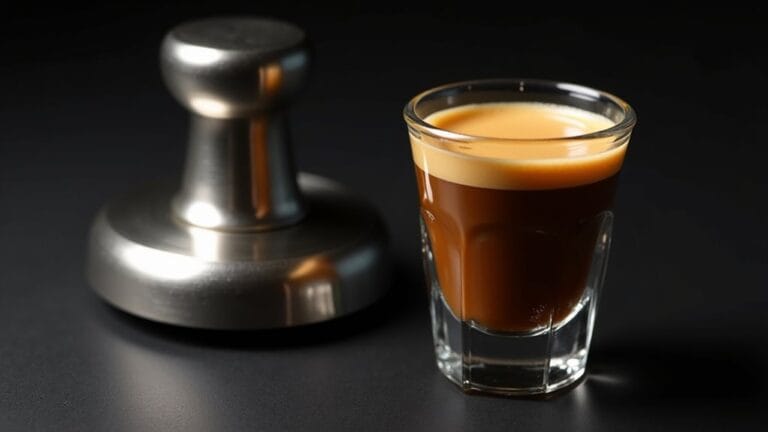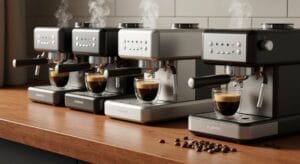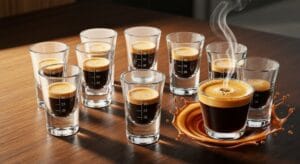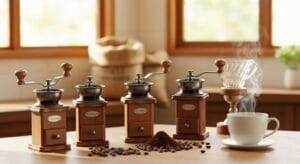Introduction: Why Precise Espresso Measurement Matters

If you’ve ever sipped one espresso that tasted like melted chocolate heaven and the next one like bitter battery acid, the difference could be something as tiny as half an ounce!
Knowing how many ounces in a shot of espresso keeps flavor twins instead of evil twins. Hitting the exact espresso shot ounce locks sweetness, lets sour or bitter sneak away, and tells your taste buds exactly what to expect next time.
Careful weighing teaches how much is one shot of espresso in real life, not in grandma stories, shrinks dumped beans, shortens cleanup time, and saves money for more cheer in every cup!
By aligning your pours with industry standards of the Specialty Coffee Association, every shot you serve meets the same high bar witnessed in top cafés worldwide.
Standard Espresso Shot Definitions
Coffee culture clings to a few golden rules, and one pops up in every café chat: a shot of espresso must hit a neat one-fluid-ounce bull’s-eye. A 25-30ml normale is the traditional Italian benchmark, sitting neatly in that ounce territory.
| Shot Name | Fluid Ounces | Coffee Grounds (grams) |
|---|---|---|
| 1 shot espresso | 1 oz | 7–9 g |
| Double espresso | 2 oz | 14–18 g |
| Triple espresso | 3 oz | 21 g |
Asked how many ounces in a double shot, the chart yells, two! That simple table nails basic espresso shot size so even a kid can brag at recess, and no one gets soggy with extra blah blah.
Weight vs Volume Measurement Methods
A shot of espresso is judged by how much ground coffee goes in (we weigh it in grams) and how much liquid comes out (we eye it in ounces like milk, ha!).
The simple fraction between these two numbers is called the brew ratio, which tells us if the drink will taste strong or watery.
Coffee Input Measurement (Grams)
Scales steal the show, because grams beat scoops every time! Ask how many grams for double espresso; the magic window is 18 to 20 grams, with most baristas parking at 18.5 grams like pros.
Leave your silly spoon in the drawer—beans squish, granules differ, and each scoop fools the eye, dumping chaos into the cup. Espresso weight keeps brew buddies happy and lasers your ratio steady, not a guessing carnival.
Italian elders? They sneak by on 14 grams, but US cafés and lab dudes high-five the bigger pile. Grind size dances in later, but right now just weigh, don’t trust volume.
Liquid Output Measurement (Ounces)
One single shot pours 1 ounce, and a double tips the cup at 2 ounces, but—plot twist—ounce can mean either volume (how much stuff fits) or weight (how heavy the stuff is), and in espresso those two are definitely not the same beast!
A 1 shot of espresso in oz of liquid measures 30 milliliters by volume, yet that same ounce by weight is 28 grams, so scales and measuring cups won’t match.
Baristas chasing precision perch a cup on a digital scale to learn exactly how many oz in a shot of espresso, grams included, dodging airy crema tricks.
To know how many oz is a double shot of espresso, the machine blinks: 2 ounces stated, yet scales sing its tiny difference. Furthermore, espresso’s caffeine density plays a role in how one experiences its effects compared to drip coffee.
Understanding Brew Ratios
When brewing espresso, the real magic happens once folks lock in the brew ratio—how many grams of dry coffee go head-to-head with how many grams of wet espresso come out—and since this number rules flavor, color, and the “whoaaa” factor in every sip, serious baristas ditch the ounce lines and let tiny scales do the talking.
Stop guessing ounces in a shot of espresso; grab a scale. Dump 18 espresso double shot grams in, pull 36 out—boom, 1:2 magic! Crema tricks eyes, weight tells truth.
Ratios rule, volume drools.
Tools and Techniques for Accurate Measurement

Grab a tiny shot glass, a kitchen scale, and a timer, because these three buddies make measuring espresso super easy!
Initially, pop the empty shot glass on the scale, hit “tare,” grind 7-9 g (weighed again), pull the shot, and stop at 25-30 seconds for that magic 1 oz, simple as pie!
And hey, timing matters like a playground race—count aloud so you nail the flow and the tasty size every single time!
Essential Measurement Equipment
Because a perfect little espresso can turn into a muddy puddle if the measuring gear goes bananas, baristas and kitchen wizards rely on tiny tools to keep the tiny drink tidy!
They grab espresso measuring cups with clear ounce lines, plop them under the portafilter, and watch gleaming black gold hit the mark! For hardcore numbers, a precision digital coffee scale sits snugly under the cup, flashing exact grams so dosing stays spot-on.
Two cute shot glasses lined up like happy twins make double shots a snap, each one ticking up to one ounce, proving the flow is fair. These pals turn guesswork into “whoa, super exact!” every morning, so flavor never plays hide-and-seek!
Step-by-Step Measurement Process
Precision walks into the kitchen wearing a goofy grin and says, “Let’s lock this tiny drink down!”
Baristas slide a clean portafilter onto a snappy digital scale, tap “tare” to knock the screen back to zero, then grind and weigh the exact grams of coffee listed for the basket size: 7–9 for a single, 16–18 for a double, 20–22 triple, no wiggle room!
Now, extra clue: one shot of espresso is how many ounces? Around one!
Question two: how much is a shot of espresso? Roughly one ounce!
Final pop quiz: how many oz is one shot of espresso? Still one!
They park the cup on the same scale, brew, and eyeball 36 g—that’s the double—because the 1:2 rule rules! The espresso should be brewed under specific parameters to achieve that perfect extraction and rich flavor.
Timing Your Extractions
A tiny clock, a button, and twenty-something moments decide whether the espresso tastes like liquid candy or burnt toast, so baristas watch the timer as closely as they watch the beans!
Most shots land between 22–26 seconds, turning ground coffee into yummy espresso ounces every single time, no matter if it is a cute single or a bold double shot espresso weight! Brewing processes, similar to those in a Moka Pot, utilize precise timing to achieve rich flavors. They start counting from the initial drip to keep things standard, skip the splashy preinfusion part, and stop at 27-ish seconds max. Built-in machine timers, phone stopwatches, or fancy scale-timers all rock, so long as someone uses the same tool every round.
Also, the extraction temperatures significantly influence the flavor profiles of the final shot, contributing to that sweet success we all crave! Write it down, tweak the grind when the clock drifts, and laugh at how much is a double shot of espresso when it is dialed in—sweet success!
Common Measurement Issues and Solutions
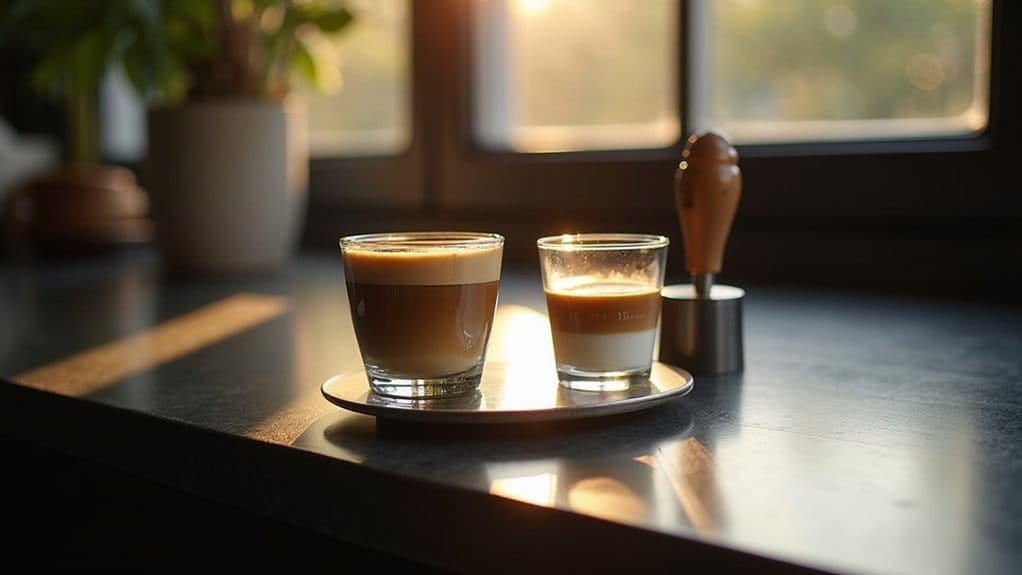
Ever notice how that tiny espresso shot can look huge one day and teensy the next?
- A sloppy spoon dump sending 10 instead of 7 grams flying, so 1 shot espresso ml jumps from 30 to… who knows?
- Lumpy powder burps like boulders clog the filter, so espresso size wobbles from gloopy to gusher.
- The tamp leaning like a tipsy leprechaun turns the double shot into how many grams of espresso in a double shot? Maybe 16, maybe 19.
- Leftover gunk clogs the shower screen, making the machine sneeze uneven spurts and drip gray mystery water.
Grab a scale, measure 14–18 g, brush the filter, tamp level every single time, and those tiny cups smile back at you!
Achieving Consistent Espresso Results
Because making a teeny espresso is like stacking a tower out of LEGO bricks—every brick counts—baristas start by nailing the coffee weight, grind, and tamp time after time.
They weigh the coffee double shot weight to 18 grams, lock the grind so each speck looks like table salt, then press the tamper with steady pressure to build a flat puck.
Next, they pull the shot for 25–30 moments, watching for 2 ounces of liquid honey; this answers how many oz is 2 shots of espresso and tells exactly how much is two shots of espresso.
Espresso serves as the bold caffeine foundation for the drink, enhancing its overall flavor profile.
They taste, tweak, taste again, chase the same yum every single cup, rinse, cheer, and repeat!
Frequently Asked Questions
Does Grind Size Affect Espresso Shot Volume?
Does grind size affect espresso shot volume? Studies reveal a 5% grind tightening shrinks output by 4 mL under fixed flow, demonstrating granular particle distribution directly modulates yield volume.
Do Decaf Beans Weigh the Same as Regular?
Decaf beans average almost the same pre-roast mass as regular; caffeine loss offsets minor water uptake. Post-roast drying equalizes weights to within negligible variance negligible for dosing protocols
Can Altitude Change Espresso Shot Measurements?
Altitude does not change espresso shot measurements directly because ounce volume remains fixed; pressure and temperature variations at elevation may alter extraction dynamics, yet targeted yields stay driven rather by settings and barista adjustment protocols.
Should I Measure Espresso Before or After Crema?
A fleeting marble-white crest crowns espresso’s dark sea; measure after this lunar foam settles. Industry tallies volume with crema encompassed, aligning palate, practice, and standard; discard pre-crema illusions.
Does Double Spout Alter Individual Shot Volumes?
Double spout retains basket volume; divides 2 oz into twin 1 oz streams, consequently individual portion equals half regardless of flow division without altering total extraction yield or recipe.

